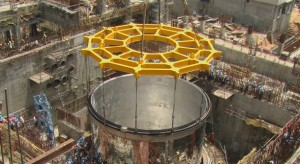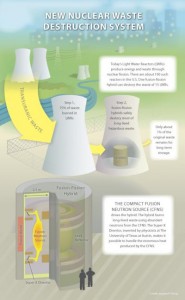Fast-Neutron Reactors May be the Key to Quickly Ridding the World of Nuclear Waste
By Leigh Kim on March 14, 2013 | RSS
China, India, and Russia are promoting the use of fast reactors in order to break down stores of nuclear waste.
Last week at a global conference sponsored by the International Atomic Energy Agency
(IAEA), India and Russia discussed large demonstration plants they will
operate in 2014 and the plan for future deployments. China is currently
making a huge R&D push so that by 2030, fast reactors are one-fifth
of the country’s nuclear capacity.
Fast-neutron reactors
are a viable option for breaking down nuclear waste because they need
only 2% of the space typically required by a conventional reactor. So,
instead of nuclear waste remaining in storage for 300,000 years under
conventional methods, fast reactors would decrease the time to 300
years. This will ultimately reduce some of the need for geological
repositories.
Experts at the IAEA conference did note that dangers accompany fast reactors.
These dangers were on the minds of nearly all attendees since the
conference wrapped up a few days before the two-year anniversary of the
Fukushima accident in Japan.
Fast reactors have molten sodium that
cools their cores. It explodes on contact with water and oxygen. The
sodium-cooled fast reactor, or SFR, exhibits what physicists call
positive reactivity. Unlike conventional reactors, which experience
their fastest possible chain reaction when operating at full power, the
SFR’s chain reaction is capable of further acceleration than its
equipment is designed to handle. This puts such reactors at greater risk
of a runaway reaction that could cause a core meltdown or breach its
steel containment vessel.
To make fast reactors a viable option, fuel safety and prevention of catastrophic accidents must be top priorities
Fusion-Fission Hybrid Reactor: Getting Rid of 99% Nuclear Waste Cleanly
By Ovidiu Sandru on January 28, 2009 | RSShttp://www.greenoptimistic.com/2009/01/28/fusion-fission-hybrid-reactor/#.UUFrfDcyqSo
The
main problem with nuclear power is that it leaves radioactive residues
behind; otherwise, it would be the almost perfect solution for our
energetic and climate crises. The US government wants to build extra
storage sites for collecting and burying what’s left behind the nuclear
power plants. They plan to dig a huge cave in the Yucca Mountain in
Nevada, but doing that is both costly and dangerous. In addition, the
work would only be finished in 2020, and it would store only about
77,000 tons of waste. I say “only” because this amount of waste is going
to be exceeded by the actual nuclear plants until 2010.
The
almost-perfect solution comes from the physicists at the University of
Texas at Austin, who created a way to “use fusion to relatively
inexpensively destroy the waste from nuclear fission,” says Mike
Kotschenreuther, senior research scientist with the Institute for Fusion
Studies (IFS) and Department of Physics. “Our waste destruction system,
we believe, will allow nuclear power-a low carbon source of energy-to
take its place in helping us combat global warming.”The scientists want to destroy the waste using a fusion-fission hybrid reactor, having a high power Compact Fusion Neutron Source at its core.
There are more than 100 fission reactors in the US. They are called “light water reactors”, or LWR. The fission reactors are the ones that actually produce energy, but they only use about 75% of the uranium’s capacity.
If you remember, we talked a while ago about fusion reaction, as being a source of energy. A fusion reactor has a magnetic device named “tokamak”, preventing the fusion reaction’s high temperature (more than 100,000,000°C) to melt down the walls of the very chamber the reaction is taking place in. The crucial invention that would pave the way for a CFNS is called the Super X Divertor. The Super X Divertor is designed to handle the enormous heat and particle fluxes peculiar to compact devices; it would enable the CFNS to safely produce large amounts of neutrons without destroying the system.
So, first of all, 75% of the waste is being destroyed during normal operation. This stage does not destroy highly radiotoxic, transuranic, long half-time waste, what the scientists call “sludge”.
The second step consists in the use of a CFNS-bases fusion-fission hybrid, who is able to burn the radioactive sludge contained in 10 to 15 LWRs, operation that also produces energy.
These two steps will destroy the nuclear waste in proportion of 99%, the rest remaining to be buried.
Scientists say this is a “bridge technology”, that will allow us to both produce energy efficiently and save some clean air by removing the coal-powered plants altogether, until solar and “pure fusion energy” are developed for everyone to use cheaply, and the ex-coal and oil industry to change their working profile – the real big problem with clean energy (money).


Tidak ada komentar:
Posting Komentar